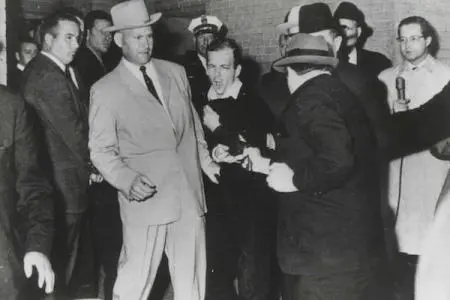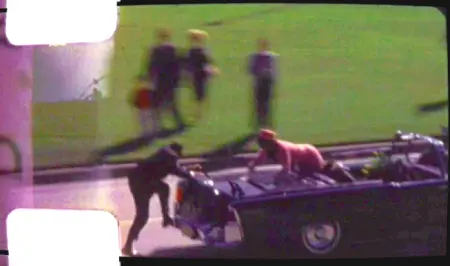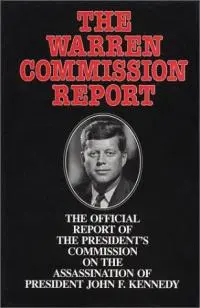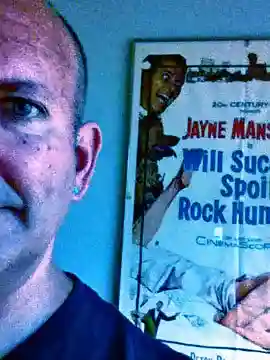“Where were you on the day they shot Kennedy?” is probably the most treasured of all baby-boomer reminiscences. Like everyone else, I know exactly where I was: in a second-grade classroom at Fairmount Elementary School, Brackenridge, Pennsylvania on November 22, 1963. Our teacher, Mrs. June Stover, who was everyday glamorous in high heels, clacked out of the classroom when the principal, Mr. Chalmers Gould, came knocking, and returned in a state of shocked agitation. “The President was shot, and you’re all going home,” she said. I was glad to be knocking off early but guilt-ridden because my unexpected liberation from school came at the price of the President’s life. Couldn’t they have just shot him in the arm? I liked Kennedy, and it didn’t seem to be a fair trade-off. We were a Kennedy family. I had just turned four on the day he was inaugurated, and my mother plunked me down in front of the television and said, “Watch this. It’s important.” I remember it to this day.
But the “Where were you?” question has a hidden meaning; they shot Kennedy, it asks, not he shot Kennedy. He. Lee Harvey Oswald. The supposed lone gunman. I did not happen to be watching TV at the moment that Oswald himself was shot to death by the Dallas strip club operator Jack Ruby on live television, but the three networks replayed the moment so often over the next few days that I may as well have been. ˙He shot Kennedy, and Ruby shot him, which only intensified the tentative belief that Oswald was not only guilty but the only one who was guilty.
The Warren Commission, convened to assure a nervous America that absolutely everything was done to investigate the assassination, concluded that indeed Lee Harvey Oswald was the only assassin. I hated Oswald. I hated Dallas, where schoolchildren were said to have erupted into cheers at the news of the President’s murder. I hated Jack Ruby, because true justice could not be served on Oswald since a sleazebag strip club owner took it upon himself to play jury, judge, and executioner all in a matter of seconds.
It did seem a little odd, though, even to a six-year-old, that Ruby could just waltz right into the police station where the presumed killer of the President of the United States was being held, muscle his way to the front of the line of bystanders watching in the building’s basement as Oswald was being transferred from the city jail to the county jail, and shoot him point blank in the gut. It seemed more than a little sloppy on the part of the Dallas police. I remember thinking uncharitably that if we were lucky maybe somebody would step up and do the same thing to Ruby.
To commemorate the 53rd anniversary of the assassination, I decided to read and report on conspiracy theory books for LitReactor. The first problem was winnowing down the field to a manageable level. There are many conspiracy theory books out there – scads of them. I decided to pick two: Joseph McBride’s Into the Nightmare: My Search for the Killers of President John F. Kennedy and Officer J.D. Tippit, and Josiah Thompson’s Six Seconds in Dallas: A Micro-Study of the Kennedy Assassination. Why these two and not, say, Reclaiming History: The Assassination of President John F. Kennedy by Vincent Bugliosi; or The Day Kennedy Was Shot by Jim Bishop; or Retired Dallas Police Chief Jesse Curry Reveals His Personal JFK Assassination File, by Jesse Curry; or Legend: The Secret World of Lee Harvey Oswald by Edward Jay Epstein; or The Kennedy Assassination Cover-Up, by Donald Gibson; or On the Trail of the Assassins: My Investigation and Prosecution of the Murder of President Kennedy, by Jim Garrison? Because I knew that McBride and Thompson weren't wackos.

Who's Who?
Joseph McBride is a renowned film historian who has written three books on Orson Welles, two books on John Ford, a book on Howard Hawks, and a book on Stephen Spielberg, among others. I have been reading his work for years, and I respect him enormously. He is clearly not a wacko. And Josiah “Tink” Thompson was a brilliant and very respected philosophy professor at Haverford College when I was a freshman there in the 1970s. I remember attending a presentation he gave about the Kennedy assassination and finding it extremely disturbing and very convincing. Thompson then quit his teaching job at Haverford and became a private investigator, a choice I found both unusual and admirable. Career academics who crave tenure might consider Thompson’s choice to be evidence of wackodom, but I don’t.
But we’ll start with neither Thompson nor McBride but instead with the Warren Commission Report, the official investigative account of the assassination, the conclusions of which are, in two words, literally unbelievable. It is the Warren Commission’s sheer incredibility that is responsible for the plethora of conspiracy theories.
Straining Belief
Established by President Johnson only a week after the assassination elevated him to the presidency, the Commission was chaired by Chief Justice Earl Warren, and it presented its findings to Johnson ten months later. The Commission’s conclusion was that Oswald acted alone; Jack Ruby also acted alone; and, ludicrously, that one of Oswald’s bullets had struck Kennedy in the back, passed through his body, exited through his throat, entered the back of Governor John Connolly, who was in the front seat of Kennedy’s limo and who survived the shooting, lodged in Connolly’s thigh, and finally ended up on a gurney at Parkland Hospital, where Kennedy and Connolly were taken, having fallen out of Connolly’s leg. As the Wikipedia entry for “Single Bullet Theory” dryly but hilariously notes, for the theory to hold true, this bullet must have “traversed 15 layers of clothing, 7 layers of skin, and approximately 15 inches of tissue, struck a necktie knot, removed 4 inches of rib, and shattered a radius bone…. While the bullet's nose appeared normal, the tail was compressed laterally on one side.” Connolly himself thought the theory was hogwash.

A Film by Abraham Zapruder
In a related finding, the Commission stated unequivocally that all of the shots came from behind Kennedy – this despite the fact that the so-called Zapruder film clearly shows Kennedy jolting back in his seat, not forward, as he would have done if he’d been hit from behind. This occurs immediately before what is, to me, the most poignant moment in the film: something flies off of Kennedy’s body and onto the trunk of the car – a piece of skull? brain matter? – and Jackie Kennedy, acting on instinct, climbs on to the trunk to retrieve it, only to be pulled back into the car by a Secret Service agent.
The Zapruder film is the amateur footage taken by a bystander, Abraham Zapruder, who just happened to be filming the Kennedy motorcade at the moment the first shot rang out. Luckily for history, Zapruder didn’t panic at the sound of gunfire and hit the ground or go skedaddling away but instead just kept on filming steadily. The footage serves as the basis for many of the conspiracy theories that have arisen since that dark day in Dallas. McBride calls the Zapruder film one of the most important films of the 20th century, second only to Citizen Kane.
Six Seconds in Dallas relies heavily on the Zapruder film to reach a very different set of conclusions than the Warren Commission’s. Thompson, using the kind of rigorous logic that is the province of a philosophy professor, reaches his conclusions after an exhaustive exploration of the evidence, largely – but not entirely – taken from the Zapruder film.
Astoundingly, rights to the Zapruder film ended up in the private corporate hands of Time, Inc., which successfully prevented Thompson from using frame enlargements to illustrate his book. But he did get the opportunity to examine the footage extremely closely, and his book is illustrated with shockingly accurate artist’s renditions of many of the frames. (These drawings look so much like the real film that Time, Inc. sued Thompson for copyright infringement; the court ruled in Thompson’s favor.)
After carefully considering the facts of the case and all of the available evidence, Thompson concludes that there were three assassins, not one; that Oswald was probably not even one of them; and that four shots were fired: the first from the now-infamous Texas School Book Depository, the second from the Dallas County Records building, and the third and fourth from the Book Depository and the famous grassy knoll, the patch of green on the hillside overlooking Dealey Plaza, where the assassination took place. The first of these shots hit Kennedy in the back; the second hit Connolly; and the third and fourth hit Kennedy in the head almost simultaneously, effectively blowing his brains out.
Who Was J.D. Tippit?
 McBride more or less agrees with Thompson, but his main contribution to Kennedy assassination theories is his argument that the killing of police officer J.D. Tippit soon after Kennedy was shot is in fact the “Rosetta Stone” of the whole conspiracy and cover-up, by which he means that the Tippit killing provides the cryptic key to understanding the whole thing. It’s a complicated argument, not easily summarized, but the gist of it is that Tippit, previously seen as collateral damage to the Kennedy killing, was actually at the heart of the conspiracy. For some unknown reason, Tippit was driving a police car in the Oak Cliff neighborhood of Dallas soon after the assassination and was seen tearing down the road minutes before he was found shot to death on the street next to his squad car. Curiously, Oak Cliff was Jack Ruby’s neighborhood, and Oswald’s too; both lived nearby.
McBride more or less agrees with Thompson, but his main contribution to Kennedy assassination theories is his argument that the killing of police officer J.D. Tippit soon after Kennedy was shot is in fact the “Rosetta Stone” of the whole conspiracy and cover-up, by which he means that the Tippit killing provides the cryptic key to understanding the whole thing. It’s a complicated argument, not easily summarized, but the gist of it is that Tippit, previously seen as collateral damage to the Kennedy killing, was actually at the heart of the conspiracy. For some unknown reason, Tippit was driving a police car in the Oak Cliff neighborhood of Dallas soon after the assassination and was seen tearing down the road minutes before he was found shot to death on the street next to his squad car. Curiously, Oak Cliff was Jack Ruby’s neighborhood, and Oswald’s too; both lived nearby.
McBride is very taken by Oswald’s statement after his arrest, “I’m just a patsy,” suggesting that he’d been set up to take the fall after other people killed the president. Was Tippit involved? McBride thinks so. Tippit may well have had more involvement with the radical right-wing elements in Dallas at the time than was previously known; these right-wingers were a shadowy collection of white supremacists and John Birch Society members that McBride suggests was behind the assassination. (The John Birch Society is a radical right organization known for its crankish embrace of ultraconservative political positions, including, ironically, the failed quest to impeach Chief Justice Earl Warren.)
McBride also points out the unlikeliness of the Warren Commission’s assertion that Oswald also killed Tippit. McBride interviewed Tippit’s father and learned something new. As McBride told an interviewer at the time of his book’s publication:
“Mr. Tippit told me that a Dallas police officer had gone to J.D.'s widow, Marie, and said J.D. and he had been sent to hunt down Oswald in the aftermath of the assassination — but that this second officer had not made it because he was in a traffic accident. I found evidence there was indeed a traffic accident nearby around the time of the shooting. The significance of this is manifold, because at the time, Oswald's identity, officially, was not known to the Dallas Police Department, which indicates that Tippit was part of a plot to frame or perhaps murder Oswald."
Oswald was later found at a movie theater in Oak Cliff and arrested.
Both researchers note the fact that although the gunman had to have been on the sixth floor of the Book Depository, Oswald was seen on the first floor a very short time before the assassination, He simply didn’t have enough time to get to the sixth floor and shoot the President.
Why Sneaking Into a Movie Theater Is Never a Good Idea
Oswald was arrested in an Oak Cliff movie theater, where he had been seen entering without buying a ticket by a shoe store manager whose suspicions had been aroused by Oswald’s lurking near his store’s entrance minutes earlier. (Today’s trivia question: what was the name of the film Oswald was watching for free at the time of his arrest? The answer is at the end of this article.*)
Kennedy conspiracy theories vary wildly in quality and logic, and both the best and the worst of them have served to undercut Americans’ faith in our government. Studies have shown that while most people think that there was more to the Kennedy assassination than the Warren Commission concluded, we also tend to be highly skeptical of those who question the Commission’s report. Not only do most Americans not believe the Warren Commission – we also distrust its critics, no matter how logical their arguments are. If all of this had led the country to think more critically about its institutions, it would have been a Good Thing. But instead, the Kennedy assassination and its aftermath have led only to a general, unfocused cynicism about the way the world works. We hover between credulity and scorn, naiveté about the way things work and contempt for them at the same time.
Pity.
*War Is Hell, starring Audie Murphy

About the author
Ed Sikov is the author of 7 books about films and filmmakers, including On Sunset Boulevard:; The Life and Times of Billy Wilder; Mr. Strangelove: A Biography of Peter Sellers; and Dark Victory: The Life of Bette Davis.







